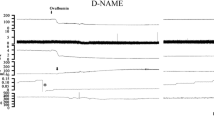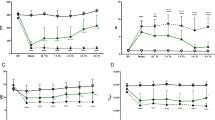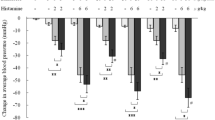Abstract
The aim of this study was to assess the role of nitric oxide (NO) in cardiac anaphylaxis regarding changes in coronary reactivity and oxidative status of the mice heart. The animals were divided into two groups: experimental group (CBA, iNOS−/− mice) and control group: wild-type mice (CBA/H). The hearts of male mice (n = 24; 6–8 weeks old, body mass 20–25 g, 12 in each experimental group) were excised and retrogradely perfused according to the Langendorff technique at a constant perfusion pressure (70 cm H2O). Cardiac anaphylaxis was elicited by injection of solution (1 mg/1 ml) of ovalbumin into the aortic cannula. For the next 10 min, in intervals of 2 min (0–2, 2–4, 4–6, 6–8, 8–10 min) coronary flow (CF) rates were measured and samples of coronary effluent were collected. Markers of oxidative stress including index of lipid peroxidation measured as thiobarbituric acid-reactive substances (TBARS), NO measured in the form of nitrites (\({\text{NO}}_{2}^{ - }\)), superoxide anion radical (\({\text{O}}_{2}^{ - }\)), and hydrogen peroxide (H2O2) in the coronary venous effluent were assessed spectrophotometrically. After the ovalbumin challenge, CF was significantly lower in the wild mice group. NO and H2O2 release were significantly higher in iNOS−/− mice group. TBARS and \({\text{O}}_{2}^{ - }\) values did not vary significantly between wild and iNOS−/− mice groups. Our results indicate that coronary vasoconstriction during cardiac anaphylaxis does not necessarily depend on inducible nitric oxide synthase (iNOS)/NO activity and that iNOS/NO pathway may not be an only influential mediator of redox changes in this model of cardiac anaphylaxis.





Similar content being viewed by others
Abbreviations
- CF:
-
Coronary flow
- eNOS:
-
Endothelial nitric oxide synthase
- HRPO:
-
Peroxidase from horse radish
- iNOS:
-
Inducible nitric oxide synthase
- IgE:
-
Immunoglobulin E
- NBT:
-
Nitro blue tetrazolium
- NO:
-
Nitric oxide
- PRS:
-
Phenol red solution
- PAF:
-
Platelet-activating factor
- ROS:
-
Reactive oxygen species
- TBARS:
-
Thiobarbituric acid-reactive substances
- TBA:
-
Thiobarbituric acid
References
Kemp SF, Lockey RF (2002) Anaphylaxis: a review of causes and mechanisms. J Allergy Clin Immunol 110:341–348
Prussin C, Metcalfe DD (2006) IgE, mast cells, basophils and eosinophils. J Allergy Clin Immunol 117:450–456
Lowenstein C, Michel T (2006) What’s in a name? eNOS and anaphylactic shock. J Clin Investig 116:2075–2078
Naito Y, Takano H, Yoshikawa T (2005) Oxidative stress-related molecules as a therapeutic target for inflammatory and allergic diseases. Curr Drug Targets Inflamm Allergy 4:511–515
Palmieri B, Sblendorio V (2007) Oxidative stress detection: what for? Eur Rev Med Pharmacol Sci 11:27–54
Coleman JW (2002) Nitric oxide: a regulator of mast cell activation and mast cell-mediated inflammation. Clin Exp Immunol 129:4–10
Saitoh J, Mitsuhata H, Takeuchi H, Hasome N, Shimizu R (1996) In vivo production of nitric oxide in the canine heart in IgE-mediated anaphylaxis. Shock 6:66–70
Regal JF, Heller LJ (1987) Cardiac anaphylaxis in isolated guinea pig hearts perfused at constant flow or constant pressure. Exp Biol Med 185:193–200
Felix SB, Baumann G, Helmus S, Sattelberger U (1988) The role of histamine in cardiac anaphylaxis, characterisation of histaminergic H1 and H2 receptor effects. Basic Res Cardiol 83:531–539
Ohkawa H, Ohishi N, Yagi K (1979) Assay for lipid peroxides in animal tissues by thiobarbituric acid reaction. Anal Biochem 95:351–358
Green LC, Wagner DA, Glogowski J, Skipper PL, Wishnok JS, Tannenbaum SR (1982) Analysis of nitrate, nitrite, and [15N] nitrate in biological fluids. Anal Biochem 126:131–138
Auclair C, Voisin E (1985) Nitroblue tetrazolium reduction. In: Greenwald RA (ed) Handbook of methods for oxygen radical research. CRC Press UNE, Boca Raton, pp 123–132
Pick E, Keisari Y (1980) A simple colorimetric method for the measurement of hydrogen peroxide produced by cells in culture. J Immunol Methods 38:161–170
Sade K, Schwartz IF, Etkin S, Schwartzenberg S, Levo Y, Kivity S (2007) Expression of inducible nitric oxide synthase in a mouse model of anaphylaxis. J Investig Allergol Clin Immunol 17:379–385
Cauwels A, Janssen B, Buys E, Sips P, Brouckaert P (2006) Anaphylactic shock depends on PI3 K and eNOS-derived NO. J Clin Investig 116:2244–2251
Gupta A, Lin RY, Pesola GR, Bakalchuk L, Curry A, Lee H, Knight RJ, Tenenbaum C, Westfal RE (2004) Nitric oxide levels in patients with acute allergic reactions. Internet J Asthma Allergy Immunol 3(1):1–4
Renzi PM, Sebastiano N, Al Assaad AS, Giaid A, Hamid Q (1997) Inducible nitric oxide synthase mRNA and immunoreactivity in the lungs of rats eight hours after antigen challenge. Am J Respir Cell Mol Biol 17:36–40
Masini E, Vannacci A, Marzocca C, Mannaioni PF, Befani O, Federico R, Toma A, Mondovi B (2002) A plant histaminase modulates cardiac anaphylactic response in guinea pig. Biochem Biophys Res Commun 296:840–846
Laukevičienė A, Uginčius P, Korotkich I, Lažauskas R, Kėvelaitis E (2010) Anaphylaxis of small arteries: putative role of nitric oxide and prostanoids. Medicina (Kaunas) 46:38–44
Forman JC (1993) Immunopharmacology of mast cells and basophils. In: Forman JC (ed) The handbook of immunopharmacology. Academic, London, pp 71–88
Funk CD (2001) Prostaglandins and leukotrienes: advances in eicosanoid biology. Science 294:1871–1875
Kawahara K, Hachiro T, Yokokawa T, Nakajima T, Yamauchi Y, Nakayama Y (2006) Ischemia/reperfusion-induced death of cardiac myocytes: possible involvement of nitric oxide in the coordination of ATP supply and demand during ischemia. J Mol Cell Cardiol 40:35–46
Djurić DM, Mitrović VM, Jakovljević VLJ (2002) The effects of calcium channel antagonists on coronary nitrite outflow in isolated rat heart. Arzneim Forsch/Drug Res 52:363–370
Djurić DM, Vuksanović A, Jakovljević VLJ (2007) The effects of folic acid and nitric oxide synthase inhibition on coronary flow and oxidative stress markers in isolated rat heart. Mol Cell Biochem 300:177–183
Rosic M, Parodi O, Jakovljevic V, Colic M, Zivkovic V, Jokovic V, Pantovic S (2014) Glucagon effects on 3H-histamine uptake by the isolated guinea-pig heart during anaphylaxis. Biomed Res Int 2014:782709
Acknowledgments
This work was supported by the Ministry of Education, Science and Technological Development of the Republic of Serbia (Grant No. 175043), and the Faculty of Medical Sciences, University of Kragujevac (Junior Project 04/11).
Author information
Authors and Affiliations
Corresponding author
Ethics declarations
Conflict of interest
The authors declare that they have no conflicts of interests relevant to the manuscript.
Rights and permissions
About this article
Cite this article
Milicic, V., Zivkovic, V., Jeremic, N. et al. Coronary flow and oxidative stress during local anaphylactic reaction in isolated mice heart: the role of nitric oxide (NO). Mol Cell Biochem 412, 221–227 (2016). https://doi.org/10.1007/s11010-015-2628-3
Received:
Accepted:
Published:
Issue Date:
DOI: https://doi.org/10.1007/s11010-015-2628-3




